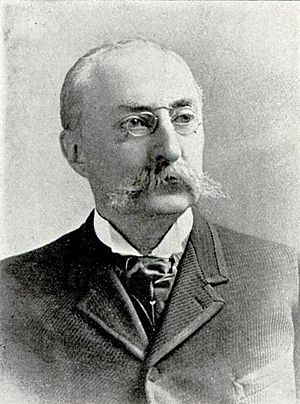Garrick Mallery facts for kids
Garrick Mallery (born April 25, 1831, died October 24, 1894) was an American expert who studied Native American sign language and picture writing, also known as pictographs. He was born in Wilkes-Barre, Pennsylvania.
Contents
Mallery's Family Background
Garrick Mallery's father, also named Garrick Mallery, was a judge and a politician. He was born in 1784 and graduated from Yale College in 1808. He served in the Pennsylvania legislature from 1827 to 1830 and worked hard to improve prisons. In 1831, he became a judge for several counties in Pennsylvania. He later moved to Philadelphia and worked as a lawyer until he passed away in 1866.
Garrick's mother was his father's second wife. Her family had important connections to Pennsylvania's history, including John Harris, Jr., who founded the city of Harrisburg, and William Maclay, one of Pennsylvania's first United States Senators.
Garrick Mallery's Education
Garrick Mallery received a great education from a young age. A private teacher prepared him for Yale College, his father's old school. He started Yale when he was fifteen and graduated in 1850.
Three years later, he earned a law degree from the University of Pennsylvania. In the same year, he became a lawyer in Philadelphia and started his practice. He also spent some of his free time writing and editing. He was doing well in his law career when the American Civil War began in 1861.
Serving in the Civil War
When the Civil War started, Mallery volunteered to serve in the army. He became a first-lieutenant in the 71st Pennsylvania Infantry. On June 30, 1862, he was seriously wounded during a battle in Virginia. He was left on the battlefield and captured, then sent to Libby Prison in Richmond, Virginia.
After some time, he was part of a prisoner exchange and sent home to Philadelphia to recover. Once he was better, he returned to the war. In February 1863, he became a lieutenant colonel in the 13th Pennsylvania Cavalry. During the military occupation of Virginia, Mallery worked as a judge advocate, which is like a military lawyer.
He left the volunteer army in November 1866. At the same time, he joined the regular army as a captain. He was recognized for his brave service during the war and was promoted to major, lieutenant-colonel, and colonel. Starting in 1870, he worked with the Signal Corps for almost ten years. In 1879, he retired from the army because his old war wounds made it hard for him to do strenuous work.
Studying Native American Cultures
While Mallery was with the Signal Corps, he was stationed at Fort Rice in Dakota Territory. There, he became very interested in how Native Americans communicated using signs and gestures. He started writing down what he observed. This led him to also study pictographs, which are pictures drawn on rocks, animal skins, and tree bark. He made many copies of these drawings.
Mallery realized that these ways of communicating might be lost as Native Americans came more under government control. Before his research, many people thought pictographs were just simple pictures without much meaning. But Mallery became convinced that gesture-speech (sign language) and pictographs were a complete system. He believed they held important information about Native American history and stories, and were connected to their spoken languages.
Joining the Bureau of American Ethnology
In 1877, because of his important work, Mallery was asked to report to Major John Wesley Powell, who was exploring the Rocky Mountains. Later, after Mallery retired from the army, Powell helped him get a job as an ethnologist (someone who studies human cultures) at the Bureau of American Ethnology. This Bureau had just been created that year.
Mallery's first publication from this work came out in 1880. It was a small book called "Introduction to the Study of Sign-language among the North American Indians." This book was a guide for students. Later that year, he published a larger book, "A Collection of Gesture Signs and Signals of the North American Indians."
In 1881, Mallery published another important work called "Sign-language among North American Indians Compared with that Among other People and Deaf-mutes." This book was very detailed and included many illustrations. Even though Mallery thought of it as just a first report, it is now seen as the first official and important study on this new topic in anthropology (the study of human societies and cultures).
He continued his work, publishing "Pictographs of the North American Indians" and his most complete work, "Picture-writing of the American Indians." This last book was very long and filled with many pictures and figures. When he died, Mallery was working on another book about Native American sign language, but his colleagues at the Bureau had to finish it.
Other Interests and Activities
Besides his major works, Mallery also wrote many shorter essays. One of his essays, "Israelite and Indian," which compared the two cultures, caused a brief discussion.
He also founded the Anthropological Society of Washington and later served as its President. He was also involved with the Literary Society of Washington, where he was a member of a main committee for many years and was its President in 1888. When he left that position, he gave a speech about "Philosophy and Specialties," where he stressed how important it was to write scientific papers clearly and elegantly.
Available Works


